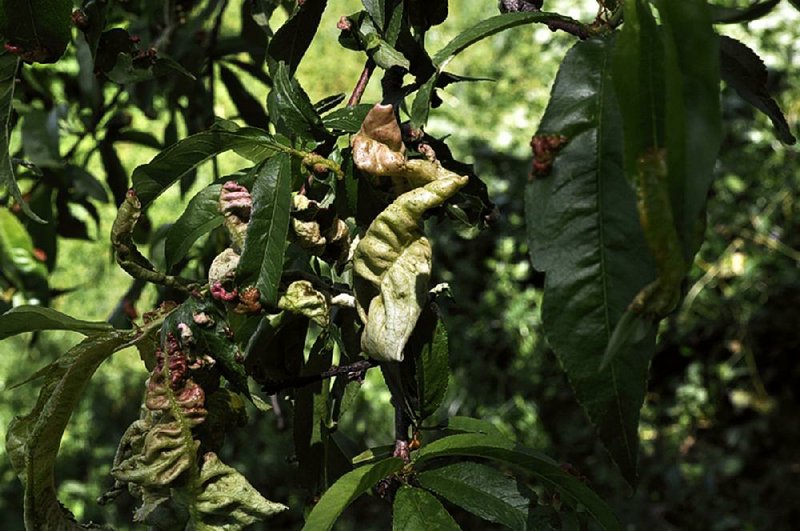Q The photo (on Page 3E) is a closeup of leaves on my 3-year old peach tree. It is representative of all its leaves. Last year it bloomed profusely and bore copious fruit. This year, no flowers - and these hideously deformed leaves. A friend who lives some 40 miles away reports exactly the same with her peach tree. What is it? What can we do about it?
A The problem is a disease called peach leaf curl, which occurs more commonly in a cool, wet spring. It causes the leaves to become thick, waxy and deformed. The disease overwinters on the tree and can only be controlled in the fall after all the leaves have fallen off or right before the leaves begin to emerge in the spring. Spraying then with a fungicide should give you preventive control.
Once you see it, there is nothing you can do to control it for that year. Heavy infestations will cause an early leaf drop, which can reduce the amount of fruit that is set. Yearly attacks will weaken the tree and eventually kill it. Once the weather warms up, the disease stops for that season, but the damage is done. For this season, rake up all the leaves when they fall and keep it watered when dry. Next fall, spray with either a fungicide containing chlorothalonil or a lime-copper spray when all the leaves have fallen off. Make sure you get thorough coverage.
Q I was out pruning my azaleas this weekend and noticed a few leaves had some white, waxy growths on them. What should I spray with and will it continue to spread and kill my plants?
A The problem is azalea leaf gall, a disease that is quite similar to the M.O. of the peach leaf curl. Luckily, it is usually not nearly as severe a problem as peach leaf curl.
The disease overwinters on the plant and if weather conditions are ideal for the disease - cool and damp - the fungus will hit. It causes the leaves to thicken. They start out a bright apple green and then turn to a white or gray as the disease progresses. Snap off the offending leaves and destroy them. Sprays are not effective nor recommended for control.
Q We thought we lost two dogwood trees during the Christmas ice storm this year. They were split and broken, so I cut them off leaving about an 18-inch stump. They have sprouted new growth. The larger tree has a lot of sprigs growing from the top of the stump, and the smaller one has several springs sprouting up from the root area. What’s the best way to train and control this new growth to shape them back into trees?
A You have a couple of options. If you want a single-trunk tree,then choose one sprout and retrain it into a tree after pruning away the other sprouts. If you leave several sprouts at the base, you will have a multi-trunked tree with branches lower to the ground. Depending on where they have sprouted, this could work. Be selective about what you leave.
Cut off other sprouts so all the growth occurs in the sprouts left. Keep watering during the growing season.
Q I dug up and planted jonquils from an old home site a year ago when they were in bloom.
However, I then mowed them down too early. They were planted on the side of a hill by a pond in Drew County.
Of course, they did not bloom this year. I have not mowed there yet this year.
Can you tell me when it will be safe to mow to get blooms next year?
A I cut down all my bulb foliage last weekend.
All spring bulbs, including daffodils, only need six weeks of green after bloom, so since yours did not bloom, they had even more time to produce food for the bulbs. I think you are perfectly safe in cutting back the foliage now.
Q We live in the Little Rock area. What kind of garlic is best to plant and when should it be planted and harvested?
A Unless you order online you will be limited in what type of garlic you can plant. While there are many varieties of garlic, usually you can find only the white soft neck and elephant garlic - which is actually not a true garlic. The best time to plant garlic is in the fall. It will overwinter and you harvest in late spring to early summer. If you don’t get around to planting in the fall, you can also plant in late winter - usually February to early March. It will delay your harvest but it works.
It is too late in the season now, so get ready for a fall planting.
Janet Carson is a horticulture specialist for the University of Arkansas Cooperative Extension Service. Write to her at 2301 S. University Ave., Little Rock, Ark. 72204 or e-mail her at
HomeStyle, Pages 37 on 05/18/2013

